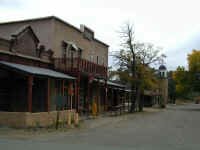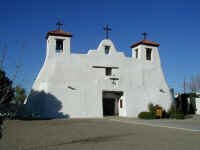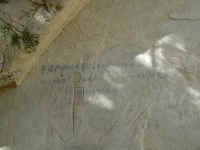October 24th
We headed out to take a look at the route of the old Santa Fe Trail as it passes on its way to Santa Fe. We found that there wasnt really anything to see. The area around town is so built up that all we could find were signs noting the trail. We moved along, our route was down along the scenic route called the Turquoise Route. This road took us past several ghost towns, most have now in the process of renovation as people move in from Santa Fe and Albuquerque.
| Cerrillos was the first of these towns. Other than a few gift shops and a quirky museum, their claim to fame is that Hollywood has shot movies on location here. |
Then there was the old coal town of Madrid. When the price of coal dropped, the town was sold off lot by lot. The most interesting place we stopped at was a little museum called Tinkertown. The owner has personally carved over 20,000 miniatures of all kinds, including a full circus. It was a really fun stop.
Next we visited ruins at Salinas Pueblo Missions National Monument. The ruins are spread out over three locations, all containing the unexcavated ruins of a pueblo together with a 17th century Spanish mission. All of the pueblos and the missions were abandoned before the end of the 17th century due to an extended drought that forced the people to move. It is thought the Puebloans even tried destroying the churches in an attempt to please their gods and end the drought.
| We ended the day with a visit and exploration of the Isleta Pueblo and mission church. Again, this church dates back to the 17th century and was impressive. |
October 25th
Today we visited the Acoma Pueblo, also known as "Sky City" because of its location atop a rock mesa. Acoma (pronounced AHK-o-ma) is one of the most historic places in North America. It vies with Old Oraibi and Walpi on First Mesa in Arizona as one of the oldest continuously inhabited villages on the continent. It has been inhabited since the 12th century and descendents claim habitation centuries earlier than that. Only about 40 people live there full time now, but many others have ancestral homes there and return home for holidays and ceremonial days.
Acoma has a long and interesting history. The arrival of the Shoshone and Athapaskan (forerunners of the Apache and Navajo) tribes in the four corners area between 1300 and 1600 proved beneficial. The Puebloans learned hunting skills from the newcomers and they in turn learned about pottery, weaving and agriculture. The arrival of the Spaniards in 1540 however proved to be disastrous.
An expedition led by Francisco Vasquez de Coronado was launched to find gold in the fabled "Seven Cities of Cibola". After searching fruitlessly and finding only cities of mud, the expedition appropriated some of the pueblos for its own use, burned one and killed dozens of Indians. Coronado returned home penniless, but this was not to be the end of the Spanish incursions into the southwest.
In 1598, a fortune seeker named Juan de Oņate led a large contingent of people up from Mexico along the Rio Grande. At the point where the Rio Grande turned west, Oņate declared all the land north of the river to be New Mexico and declared himself governor. During the first few years of Oņates rule he tried to subdue the pueblos, which led to much bloodshed. At Acoma Pueblo, one of Oņates nephews tried to exact a tax of food. The Puebloans rebelled and killed the nephew and half his force. Oņates forces responded by killing, maiming or enslaving hundreds of Indians. By 1601, Oņate and his troops had attacked three other pueblos and killed or enslaved hundreds more. While Oņate would later be recalled to Mexico City for his atrocities, the ironic legacy that he left behind was one in which he now has statues and schools named after him. This was something that I found rather hard to understand. (Although a few years ago one of the statues was vandalized in a fashion that mainly people considered appropriate: the right foot was cut off.)
Our tour around the Pueblo was led by Dale, a daughter of a former governor of the Pueblo. She was very knowledgeable and told us interesting stories about her life growing up there. There is no electricity, no running water and certainly no TV or Nintendo! Water has to be hauled from down below the mesa and light and heat for cooking and warmth are provided by lanterns, propane stoves and fires. One interesting fact about the people of Acoma, especially in contrast to the Hopi people, is that they did accept the religion of the people who tried to oppress them. There is a beautiful church built in the early 1600s that was not destroyed during the Pueblo Revolt in 1680 like so many others built by Spaniards in the Pueblos.
After leaving the Acoma Pueblo we continued west through New Mexico. This route, followed by people for thousands of years, is documented on a huge sandstone outcropping called El Morro. This 200 foot tall rock has a permanent source of water at its base that drew travelers crossing this desolate area. In the 1200s the Zuni built a small pueblo on top that was abandoned in the 1300s. During their stay they left many petroglyphs.
| After their departure, the Spaniards crossing through this area also left their signatures and stories carved in the wall. (This includes the infamous Juan de Oņate, the first non-native signer, in 1605). Anglos later carved evidence of their passing until the practice was outlawed in 1906. The history permanently written on this rock is an extremely interesting element to any trip to this part of the country. |
That evening we spent the night camped on the shores of Lyman Lake which was created in 1915 when settlers dammed the Little Colorado River. Evidence of early habitation here can be found by hiking the trails around the lake. Petroglyphs and ruins are in evidence and who knows how many more were flooded by the lake. It was a lovely spot to end our day of exploration of the pueblos and the Spanish influence on them.
The next day, the last one of this Expedition, we followed the Coronado Trail down the eastern edge of Arizona. This is the route that Francisco Coronado followed, in reverse, as he arrived in the Southwest in search of the fabled Seven Cities of Cibola described above. This route leads through the National Forest passing beautiful vistas and allowing us one last view of the changing colors of fall. All in all, it was a great way to conclude our Footsteps of the Ancients Expedition through the American Southwest. Thanks for joining us.


